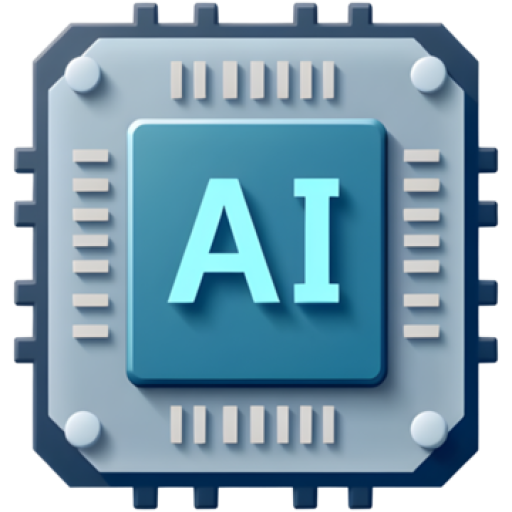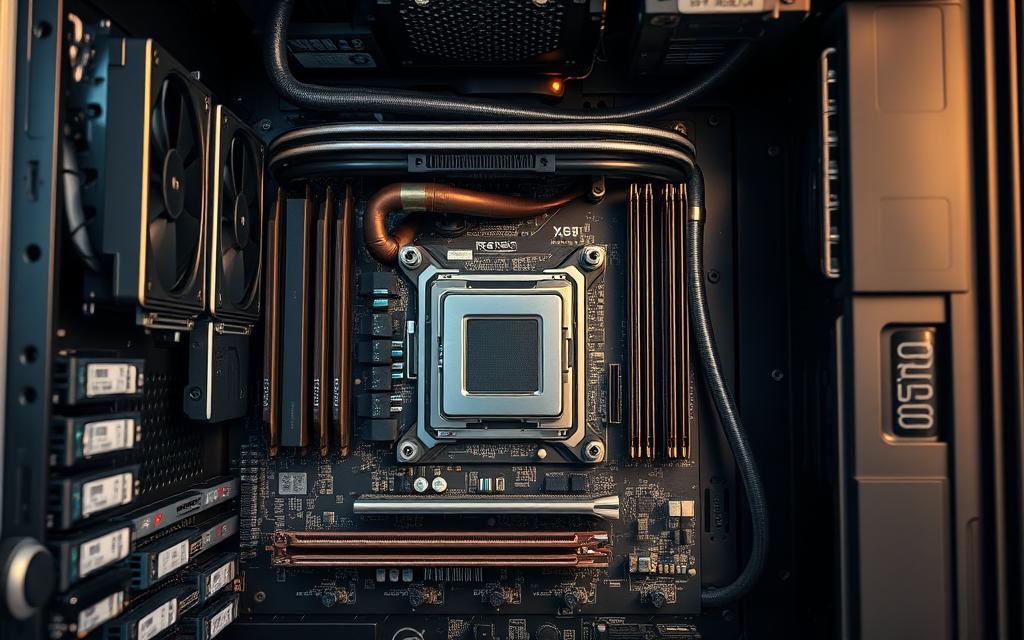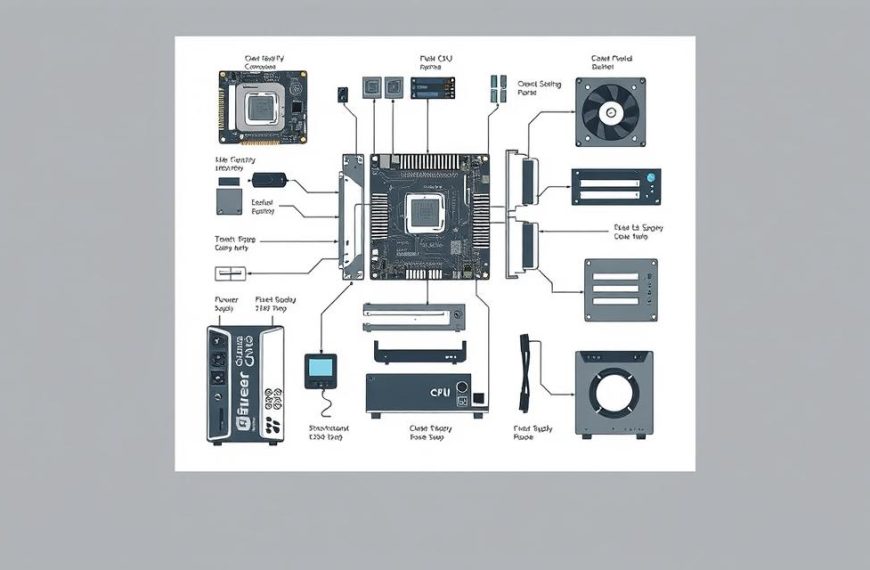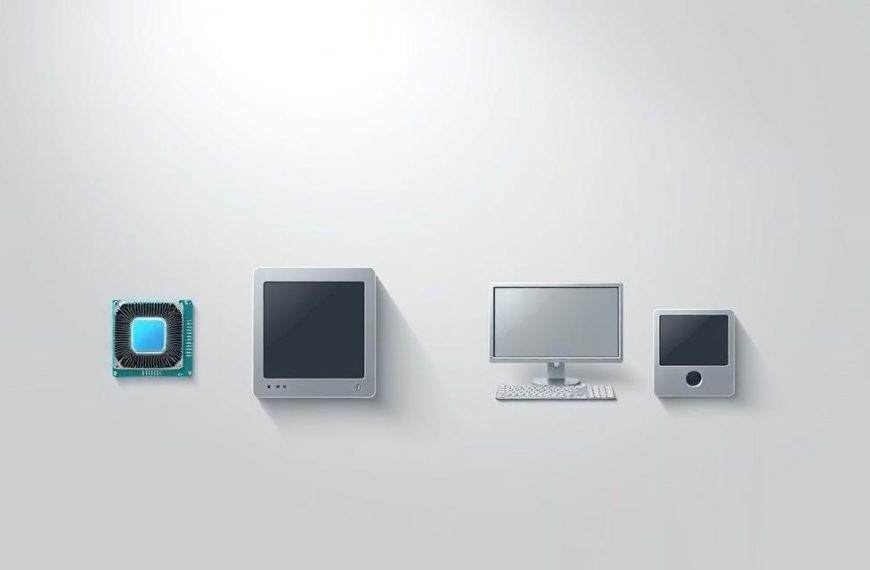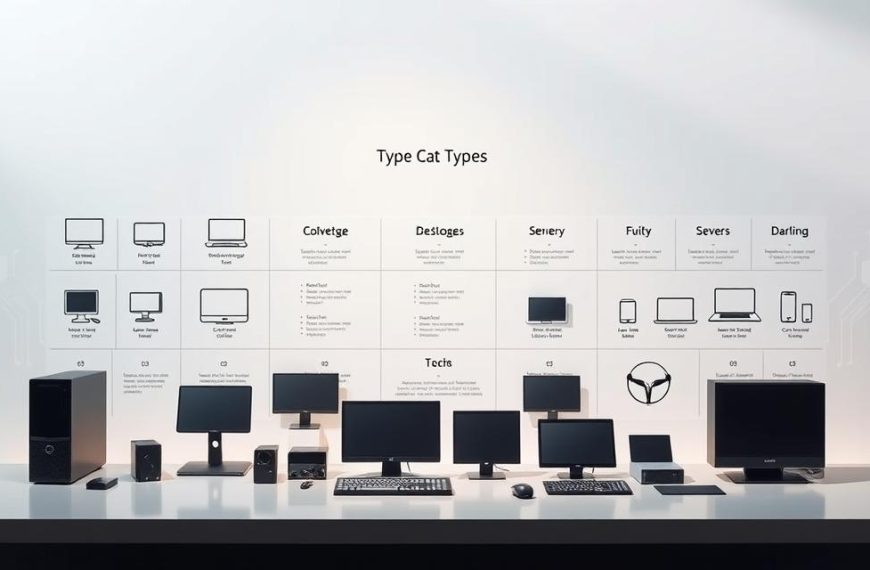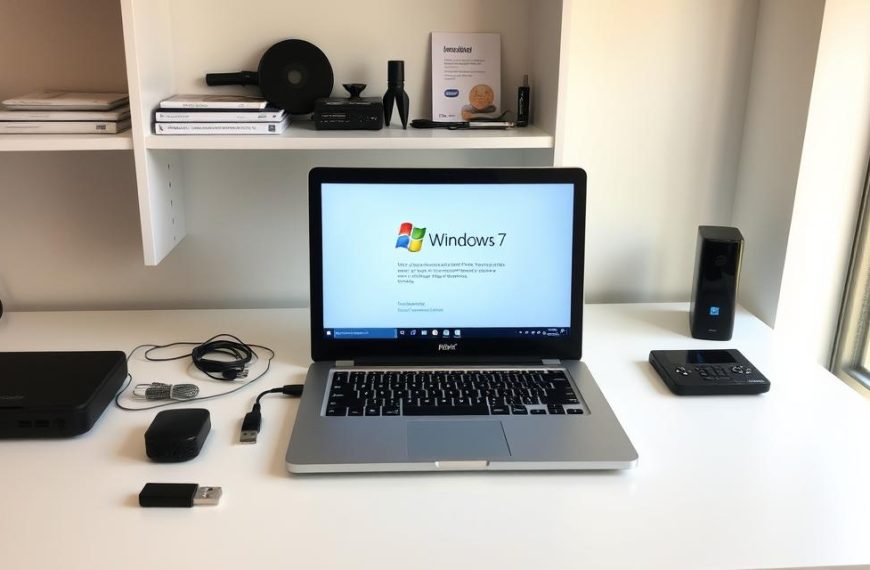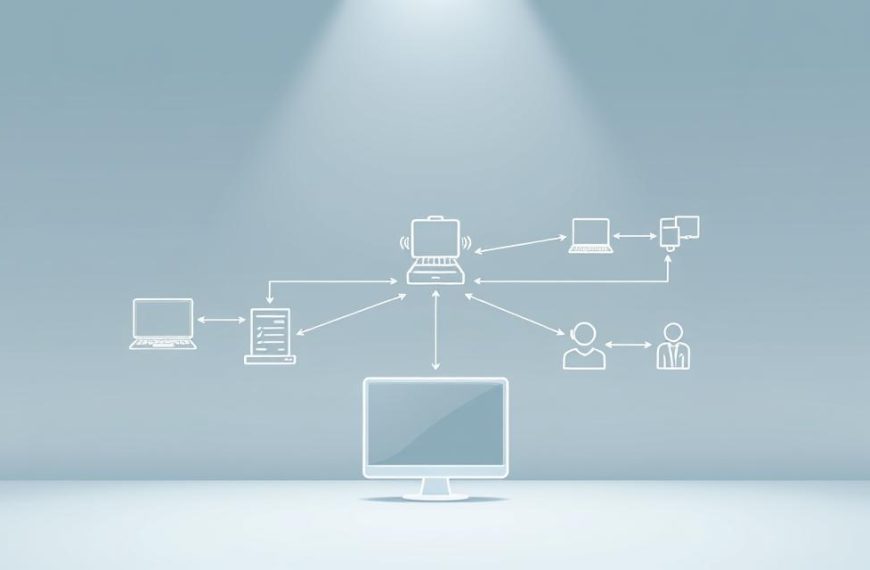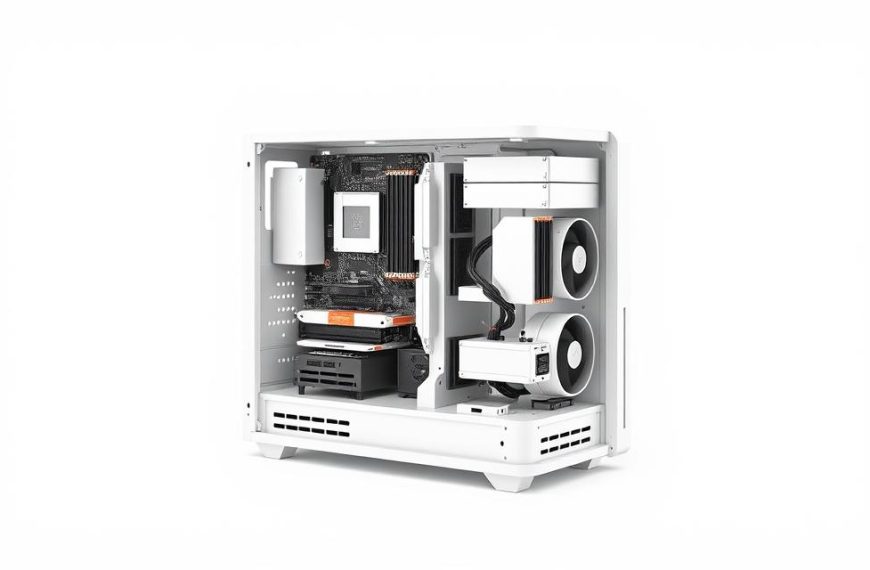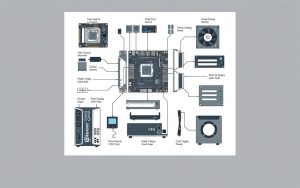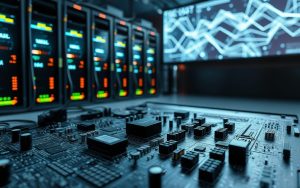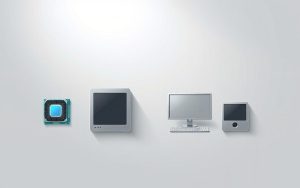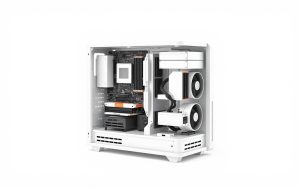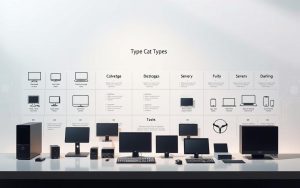The computer system unit components are the heart of every PC. They house the key parts that make computers work. This box, or chassis, keeps these parts safe and lets them work together smoothly.
Unlike things like monitors or keyboards, the internal PC hardware works quietly. It handles data, stores information, and carries out commands.
The system unit architecture starts with the motherboard. It’s like the brain of the computer, connecting everything. It ties the processor, memory, and expansion cards together.
Storage drives and power supplies are also inside. They help the computer run well. Cooling systems keep things from getting too hot during busy times.
Knowing about these parts helps us understand how computers work. Whether it’s for gaming or office work, how these parts work together matters. This guide explains what each part does. It helps users make smart choices when fixing or building computers.
Understanding the Computer System Unit
The computer system unit is the heart of all processing tasks. It holds key hardware that turns raw data into something useful. This metal frame is called the “computer chassis”. It connects components and keeps them safe from harm.
Definition and Primary Functions
A system unit has three main system unit functions:
- Power distribution to internal hardware
- Heat dissipation through ventilation systems
- Data routing between storage, memory, and processors
External vs Internal Components
Internal vs external hardware matters for how easy it is to upgrade. External parts like USB-C ports let users interact. But, sealed parts like power supply cabling need a tech expert to change.
| Component Type | Examples | Access Level |
|---|---|---|
| External | Audio jacks, SD card readers | User-facing |
| Internal | PSU cables, SATA connectors | Technician-only |
| Hybrid | Front panel USB headers | Limited user access |
Today’s computer chassis components are both strong and flexible. Top models have easy-to-open drive bays for upgrades. They also protect sensitive parts from electromagnetic interference.
The Motherboard: Foundation of Operations
The motherboard is at the core of every computer. It’s a complex circuit board that connects all hardware. Its design greatly affects a computer’s performance and how much it can be upgraded.
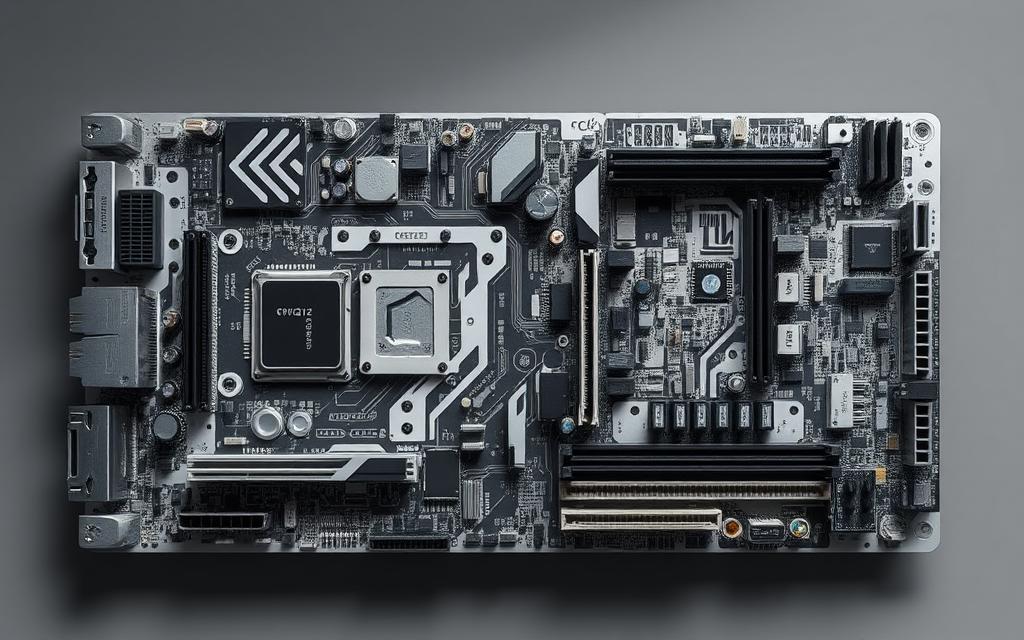
Layout and Key Sections
Today’s motherboard architecture follows set patterns for where components go. The top part usually has key processing parts. The sides have space for adding more features.
CPU Socket and Chipset
CPU socket types differ between Intel and AMD. Intel uses LGA, while AMD has PGA. The chipset, near the CPU, controls data flow. New boards often have a single chip instead of the old northbridge/southbridge setup.
RAM Slots and Expansion Bays
Memory slots have changed from DDR to DDR4 or DDR5. Expansion bay configurations include PCIe x16 for graphics and PCIe x1 for extras. The move to PCIe 5.0 has boosted speeds by over 60 times from 2003.
Integrated Components and Connectors
Modern motherboards come with key features built-in:
- BIOS/UEFI firmware for startup
- POST circuitry with diagnostic LEDs
- Multiple fan headers for cooling
Rear I/O panels now have USB-C and DisplayPort. Internal headers support USB 3.2 Gen 2. Knowing these helps users get the most from their system without extra cards.
| Interface Type | Max Speed | Common Uses |
|---|---|---|
| PCIe 4.0 x16 | 32 GB/s | Graphics cards |
| SATA III | 6 Gb/s | Storage drives |
| USB 3.2 Gen 2×2 | 20 Gb/s | External storage |
Processing Power: CPU and RAM
Every computer has two key parts: the CPU and RAM. They work together to do tasks fast. The CPU does the math, and RAM stores data temporarily. Let’s look at their specs and how they affect performance.
Central Processing Unit (CPU)
Today’s CPUs have many cores and smart designs. They handle tough tasks well. The speed, cache size, and instruction sets matter a lot.
Architecture and Performance Metrics
Now, CPUs mix performance cores and efficiency cores. This helps with both big tasks and small ones. Important metrics include:
- Base clock speeds (2.5-4.0 GHz range)
- L3 cache sizes (up to 64MB in consumer CPUs)
- Single-thread vs multi-core benchmarks
| CPU Feature | Impact | Ideal Use Case |
|---|---|---|
| 6-8 Cores | Multitasking | Content creation |
| 5.0GHz Boost | Gaming | High-FPS titles |
| 128MB L3 Cache | Data processing | Scientific computing |
Thermal Design and Cooling Needs
Fast CPUs get very hot. They need strong cooling. TDP ratings go from 65W to 250W+ for top chips. Liquid cooling keeps them cool without slowing down.
Random Access Memory (RAM)
RAM is the CPU’s quick memory. DDR5 is a big step up from DDR4.
DDR4 vs DDR5 Specifications
DDR5 brings:
- Base speeds from 3200MT/s to 4800MT/s
- Less power use (1.1V vs DDR4’s 1.2V)
- On-die error correction
| Specification | DDR4 | DDR5 |
|---|---|---|
| Max Capacity | 64GB per module | 128GB per module |
| Bandwidth | 25.6GB/s | 38.4GB/s |
| Voltage | 1.2V | 1.1V |
Capacity and Speed Considerations
Most people need 16GB DDR4. But, those who want more can go for 32GB+ DDR5. Faster RAM means quicker app starts and better data handling, like in video editing.
Storage Solutions and Data Retention
Today’s computers use different storage tech to balance speed, space, and reliability. Hard drives are old but solid-state drives and NVMe solutions are new and fast. Let’s look at how they store and get data.
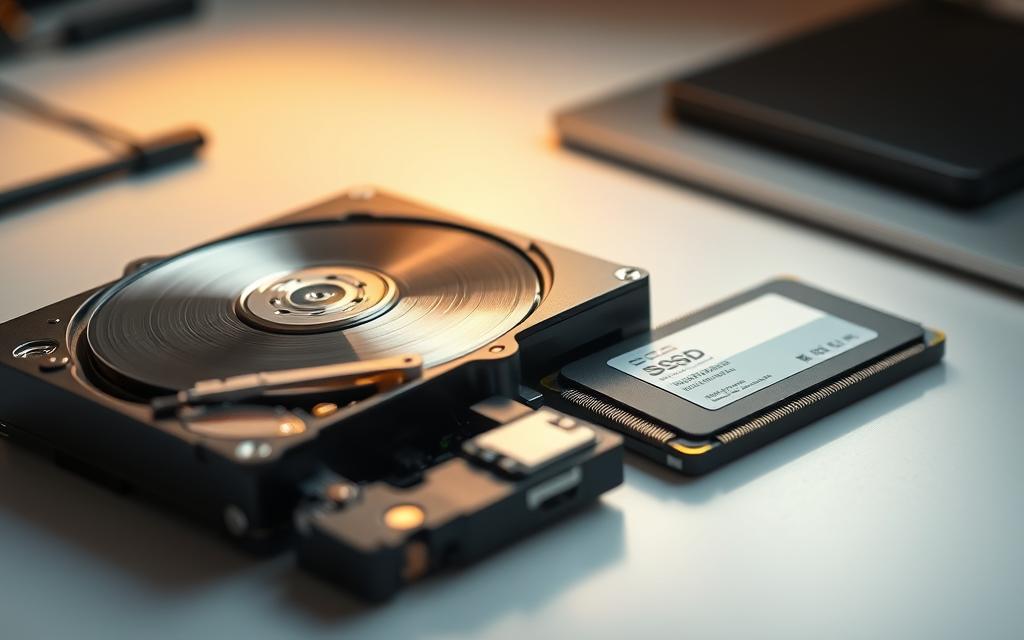
Hard Disk Drives (HDDs)
HDDs have spinning magnetic platters and moving arms to read/write data. They are big and cheap, great for storing lots of media.
Mechanical Structure and Limitations
HDDs are fragile because of their moving parts. They use a lot of power and make noise. Their speed is limited to 160MB/s by the SATA interface.
Solid State Drives (SSDs)
SSDs use NAND flash technology with no moving parts. They are quiet and fast, up to 5 times quicker than HDDs.
NAND Flash Technology and Advantages
3D NAND makes SSDs denser and cheaper. They are tough and use less power, perfect for laptops. New algorithms help them last longer.
M.2 and NVMe High-Speed Options
M.2 drives are fast because they connect directly to PCIe lanes. With NVMe, they go over 3500MB/s. They’re great for gaming and work.
| Feature | HDD | SSD |
|---|---|---|
| Speed | Up to 160MB/s | 550MB/s+ |
| Durability | Mechanical failure risk | Shock-resistant |
| Noise | Audible operation | Silent |
| Price per GB | £0.02 | £0.08 |
NVMe’s parallel command queueing eliminates bottlenecks in older systems. It lets data transfer in parallel, making storage faster.
Power Supply and Thermal Management
Two key things keep a computer running well: a steady power supply and keeping it cool. Without these, even top-notch parts can fail early or not work as well. Let’s look at how these systems help protect your computer’s hardware.
Power Supply Unit (PSU)
The PSU changes AC from the wall into DC for your computer’s parts. Wattage needs change a lot, from 300W for simple PCs to 750W or more for gaming setups.
Wattage, Efficiency Ratings, and Cable Management
PSU efficiency is shown by 80 Plus certification tiers. These show how much energy is lost as heat. Better ratings like Platinum or Titanium mean 90-94% efficiency under normal use.
| 80 Plus Tier | Efficiency at 50% Load | Typical Use Case |
|---|---|---|
| Bronze | 85% | Budget builds |
| Gold | 90% | Mid-range systems |
| Titanium | 94% | Server/workstation |
Modular PSUs make cable management easier. They let you only use the cables you need. This cuts down on clutter, improves airflow, and makes upgrades simpler.
Cooling Systems
Good thermal management systems keep parts from getting too hot. You can choose between air and liquid cooling, based on what you need and your budget.
Air Cooling: Fans and Heat Sinks
Air coolers use heat sinks and fans to cool. Fans are measured by CFM (cubic feet per minute). A 120mm fan with 50+ CFM is usually enough for CPUs. But GPUs often need more fans.
Liquid Cooling Systems
Closed-loop liquid coolers are better for cooling overclocked processors. They:
- Run 20-30% quieter under load
- Keep parts cooler
- Work well in small cases
“Prolonged exposure to temperatures above 85°C can degrade silicon chips 40% faster than recommended operating conditions.”
Liquid cooling is great for high-performance systems. But, it’s important to install it right. Leaks are rare in good AIO units, happening in less than 0.1% of cases, studies show.
Expansion and Peripheral Connectivity
Computers can grow and change thanks to their expansion slots and interfaces. These parts help users upgrade performance and add new hardware. They also connect important devices. From fast graphics cards to everyday USB items, they make your computer flexible as tech advances.
Graphics Processing Units (GPUs)
GPUs need PCIe x16 slots for high speeds. They can handle 4K gaming or 3D work smoothly. Choosing between dedicated and integrated graphics depends on your needs:
- Dedicated GPUs: Separate cards for heavy tasks
- Integrated graphics: Built-in for basic tasks and saving power
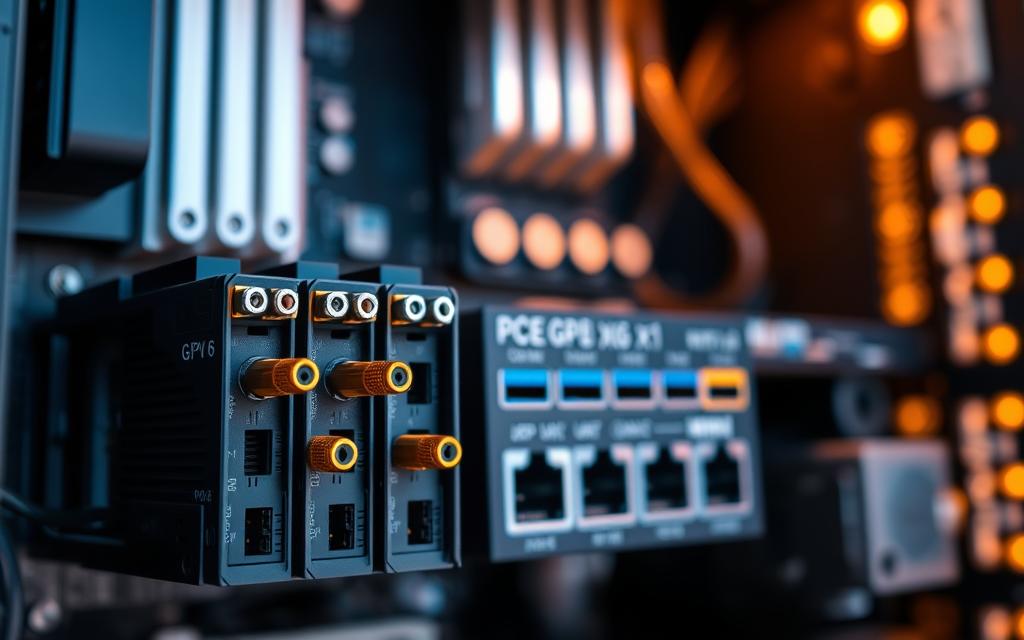
Integrated graphics save money and power. But dedicated GPUs are better for tasks like:
- Real-time ray tracing
- AI-driven processing
- Multi-monitor setups
Sound and Network Interface Cards
There are different NIC card types for various needs:
- Gigabit Ethernet for wired networks
- Wi-Fi 6/6E adapters for wireless
- Bluetooth combo cards
Top sound cards support 7.1 surround sound. They’re key for content creators. For more on how components work together, check out this guide on computer system components.
Front Panel Connections
These interfaces connect users with the computer’s core. They include:
“POST code LEDs show important boot info, displaying codes at startup.”
USB Ports, Audio Jacks, and LED Indicators
Today’s front panel headers have:
- USB 3.2 Gen 2 ports for fast data transfer
- Combined microphone/headphone jacks
- RGB lighting controllers
Older USB 2.0 ports are slower, at 480 Mbps. But modern headers help devices work well and get power right.
Conclusion
The computer system unit overview shows how key parts like the CPU, GPU, and storage rely on the motherboard. ASUS ROG or MSI motherboards are central, managing power and data flow. Upgrading with NVIDIA GeForce RTX GPUs or AMD Ryzen processors needs a matching PSU, like EVGA SuperNOVA or Corsair RMx.
Keeping your system cool is vital for its life. Noctua NH-D15 coolers or Cooler Master liquid systems stop overheating. Make sure to clean dust filters in cases like Fractal Design Meshify to keep air flowing. Always check if new parts fit your motherboard’s PCIe slots and TDP ratings.
This summary shows the importance of balance in PC hardware. Whether improving an existing setup or planning upgrades, choose parts that match your power supply and cooling. Follow guidelines from brands like Crucial for RAM or Western Digital for storage for smooth integration. With proper care and upgrades, your system will run efficiently for years.
